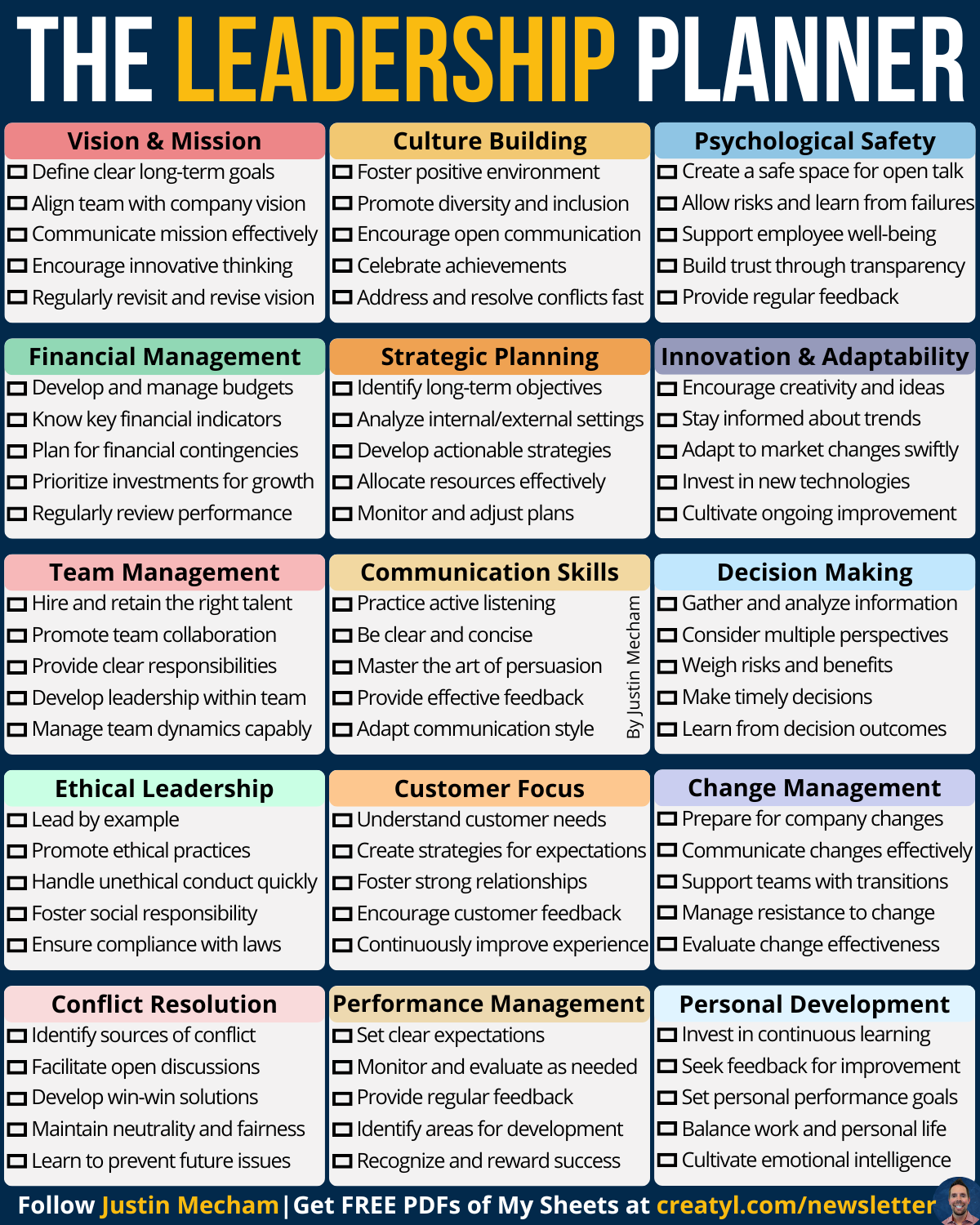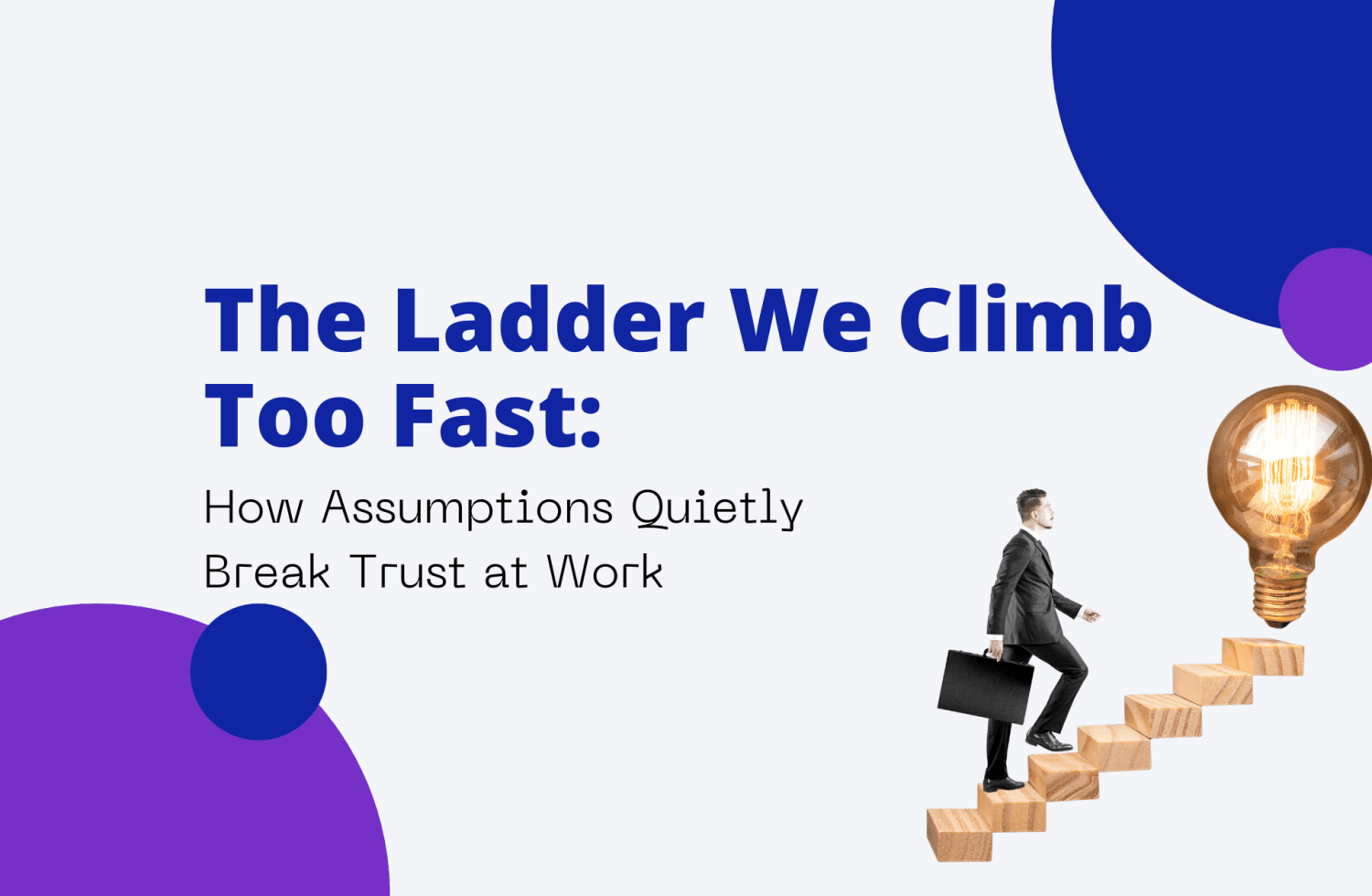Click Here to Download The PDF
Leadership isn’t one thing.
It’s not just giving a great speech.
It’s not about managing a meeting well.
And it’s definitely not just about making hard decisions under pressure.
Great leadership is built the same way strong teams are built:
One system, one practice, one area at a time.
Yet most leaders focus only on what’s screaming the loudest—whatever’s urgent, on fire, or falling apart.
They react.
They put out fires.
They try to do their best under pressure without any real framework.
But here's the hard truth:
Every team problem is a leadership problem.
And every leadership problem has a root system issue.
When you’re missing clear vision, communication breaks.
When you avoid hard conversations, trust breaks.
When your systems are reactive, everything becomes personal.
If you want real traction—
You need a system that can run daily, not just when things go wrong.
This Leadership Planner gives you that foundation.
15 areas.
Each one a pillar.
Together, they anchor teams, reduce friction, and help everyone move with purpose.
Let’s dig in.
Why Vision Fails Without Structure
Leadership without a system is like having a map with no road.
You might know where you want to go—but without a repeatable, daily structure to get there, your team ends up drifting, second-guessing, or pulling in different directions.
Most leaders focus on isolated actions:
- A team meeting here
- A 1:1 chat there
- A new initiative to fix a broken part of the culture
But they’re not always tied to a larger structure.
So every effort feels reactive.
Disconnected.
Unstable.
When your team doesn’t know what the priorities are—or how each part fits together—they’ll default to the urgent over the important.
The result?
Burnout. Missed goals. Quiet quitting. High turnover. A “meh” culture.
That’s what happens when leadership is reduced to one skill or one personality.
The best leaders do something different:
They build a system they can run every day.
One that doesn’t depend on their mood.
One that others can rely on.
One that doesn’t just fix issues, but prevents them from happening in the first place.
What Real Leadership Looks Like in Practice
Strong leadership isn’t about control.
It’s about clarity.
A great leader doesn’t have to be perfect.
But they do need to build the structure that makes success easier for everyone.
And that starts by developing across 15 essential areas:
- Vision & Mission: Where are we going? Why does it matter?
- Culture Building: Do people feel proud, safe, and supported here?
- Psychological Safety: Can we be honest, make mistakes, and still feel valued?
- Financial Management: Are we watching our numbers and using them wisely?
- Strategic Planning: Are we choosing the right long-term path?
- Innovation & Adaptability: Are we experimenting, evolving, and staying relevant?
- Team Management: Are we hiring well and developing our people daily?
- Communication Skills: Are we saying what needs to be said clearly and often?
- Decision Making: Are we gathering the right inputs—and actually committing to decisions?
- Ethical Leadership: Are we leading with integrity, especially when no one’s watching?
- Customer Focus: Are we making life easier for the people we serve?
- Change Management: Are we leading transitions with clarity and confidence?
- Conflict Resolution: Are we dealing with tension early, not letting it fester?
- Performance Management: Are we setting expectations and giving real feedback?
- Personal Development: Are we growing ourselves, not just our teams?
When these pillars are in place, everything runs smoother:
Decisions get easier.
Friction gets lower.
People know how to move forward—even when things get hard.
Real Workplace Example
A SaaS company brought me in after two failed leadership transitions.
They had smart people. A strong product. Big growth potential.
But things were falling apart internally.
The new director felt overwhelmed.
Their team didn’t trust their direction.
Key players were quietly quitting—or openly resisting change.
People were working hard, but no one seemed aligned.
The company didn’t have a toxic culture.
They had a confusing one.
And leadership was the root issue.
No one knew who was making decisions—or why.
Vision statements existed, but weren’t shared or referenced.
Performance feedback was inconsistent.
Customer satisfaction dropped, and leadership didn’t know how to respond.
It wasn’t one mistake.
It was a system breakdown.
The director was working 10-hour days trying to “fix” everything in the moment.
But they weren’t building anything that could actually scale.
I introduced the 15-part Leadership Planner.
We took two weeks to do a diagnostic:
- Where were they strong?
- Where were they completely guessing?
- What could be simplified and made repeatable?
Then we built a system:
- Vision & Strategic Planning: We clarified the 3-year vision and translated it into quarterly objectives that every department could align with.
- Communication & Feedback: We introduced a biweekly team huddle and standardized feedback sessions so that people weren’t waiting for crisis to speak.
- Psychological Safety & Conflict Resolution: We trained managers to address issues quickly—without judgment or avoidance—and use tension as an opportunity for clarity.
- Performance Management: We built a simple scorecard that tied expectations to outcomes—and left room for development, not just evaluation.
Within 90 days, the director felt in control again.
The team started saying things like “we’re finally aligned” and “this feels different.”
The leadership team wasn’t perfect.
But now, they had something to build on.
And that made all the difference.
The 4-Step Reset: Build Your Leadership System One Piece at a Time
You don’t have to fix everything all at once.
But you do need to stop managing chaos and start building structure.
Here’s where to begin:
1. Map Out Your System (Even if It’s Messy)
Print the 15 categories.
Ask yourself:
Where am I strong? Where am I weak? Where am I guessing?
You can’t lead what you haven’t defined.
2. Choose One Area to Strengthen First
Don’t try to “lead better” in general.
Start with one specific pillar—like feedback, vision clarity, or team alignment.
Then build a small, repeatable process you can run every week.
3. Make Systems Visible, Not Silent
Don’t assume people understand your leadership priorities.
Show them the system. Involve them in it.
Say:
“We’re getting better at feedback this quarter. You’ll see that in our 1:1s.”
Or:
“We’re clarifying expectations so no one’s guessing what matters most.”
Let people see leadership as something they’re part of—not something done to them.
4. Keep the Long Game in Mind
Strong leadership isn’t about perfect performance.
It’s about consistent progress.
Run the system.
Adjust what doesn’t work.
Ask for feedback.
And keep going—even when the urgent gets loud.
Curated Tools to Go Deeper
Ready to lead with more intention?
Here are some of the most useful resources to help you build leadership structure—without losing your human side.
Book
The Advantage by Patrick Lencioni
A practical guide to building healthy leadership systems—starting with clarity, alignment, and trust.
TED Talk
How Great Leaders Inspire Action by Simon Sinek
This talk breaks down the power of leading from “why”—and how vision becomes real when it’s shared consistently.
Podcast
The Craig Groeschel Leadership Podcast
Real-world strategies on leadership habits, systems, and managing teams with clarity and confidence.
Tool
Lead Honestly
A simple tool for running better 1:1s—centered on connection, feedback, and structured leadership conversations that build trust over time.
Leadership Gets Lighter When You Build the Right System
You Can’t Fix Chaos with Charisma
When you lead without a system, everything feels personal.
Every decision feels hard.
Every setback feels like failure.
Every conflict feels like a threat.
But once you build a structure—one rooted in clear pillars and repeatable actions—you start leading with confidence.
You stop putting out fires and start preventing them.
You stop doing everything yourself and start empowering others to lead with you.
You stop waiting for trust and start earning it with consistency.
Leadership doesn’t have to feel heavy.
It just has to feel clear.
And when your system gets stronger, your team will too.
Because people don’t need perfect leaders.
They need honest ones.
They need structured ones.
They need someone who’s building something they can believe in.
Download the Infographic
Want a simple way to audit and upgrade your leadership system?
Download the Leadership Planner infographic as a free PDF.
Use it with your leadership team, in your own 1:1s, or as a personal scorecard.
Click here to download the Leadership Planner PDF
Start building your system—one pillar at a time.
-
Justin




